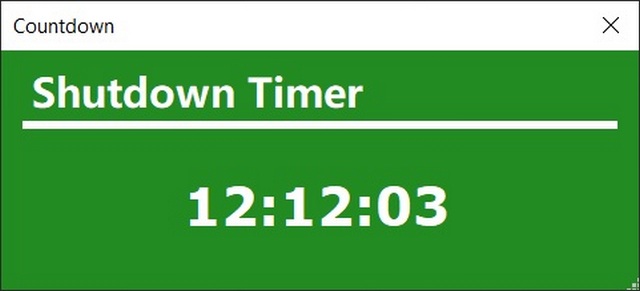

In addition to his extensive writing experience, Chris has been interviewed as a technology expert on TV news and radio shows. The company's project was later reportedly shut down by the U.S. A wave of negative publicity ensued, with coverage on BuzzFeed News, CNBC, the BBC, and TechCrunch. At CES 2018, he broke the news about Kodak's "KashMiner" Bitcoin mining scheme with a viral tweet.

Starting in 2015, Chris attended the Computer Electronics Show (CES) in Las Vegas for five years running. His work has even appeared on the front page of Reddit.Īrticles he's written have been used as a source for everything from books like Team Human by Douglas Rushkoff, media theory professor at the City University of New York's Queens College and CNN contributor, to university textbooks and even late-night TV shows like Comedy Central's with Chris Hardwick.
#Computer auto shutdown timer windows 10#
His roundups of new features in Windows 10 updates have been called "the most detailed, useful Windows version previews of anyone on the web" and covered by prominent Windows journalists like Paul Thurrott and Mary Jo Foley on TWiT's Windows Weekly. Instructional tutorials he's written have been linked to by organizations like The New York Times, Wirecutter, Lifehacker, the BBC, CNET, Ars Technica, and John Gruber's Daring Fireball. The news he's broken has been covered by outlets like the BBC, The Verge, Slate, Gizmodo, Engadget, TechCrunch, Digital Trends, ZDNet, The Next Web, and Techmeme. Beyond the column, he wrote about everything from Windows to tech travel tips.

He founded PCWorld's "World Beyond Windows" column, which covered the latest developments in open-source operating systems like Linux and Chrome OS. He also wrote the USA's most-saved article of 2021, according to Pocket.Ĭhris was a PCWorld columnist for two years. Beyond the web, his work has appeared in the print edition of The New York Times (September 9, 2019) and in PCWorld's print magazines, specifically in the August 2013 and July 2013 editions, where his story was on the cover. With over a decade of writing experience in the field of technology, Chris has written for a variety of publications including The New York Times, Reader's Digest, IDG's PCWorld, Digital Trends, and MakeUseOf. Chris has personally written over 2,000 articles that have been read more than one billion times-and that's just here at How-To Geek. Assuming your computer is sleeping, and not fully shut down - you can put it to sleep yourself or use a scheduled task that puts it to sleep - this schedueld task when wake your computer up.Ĭhris Hoffman is the former Editor-in-Chief of How-To Geek. You can also create scheduled tasks that wake your computer from sleep. It won't automatically shut down on you while you're using it if you stay up a bit late one night. Through the magic of the task scheduler, you can even have Windows wait until you're no longer using your computer to shut it down. Sleep: rundll32.exe powrprof.dll,SetSuspendState 0,1,0.Hibernate: rundll32.exe powrprof.dll,SetSuspendState.You could also run other commands to put the computer to sleep or hibernate it. Scheduled tasks can run the "shutdown" command, shutting down your computer at a specific time. Windows allows you to set boot-up and shutdown times through the Task Scheduler. This is less necessary than ever thanks to sleep mode - a typical laptop just enters low-power sleep mode it can quickly resume from when it's not being used - but may still be useful for desktop PCs.


 0 kommentar(er)
0 kommentar(er)
